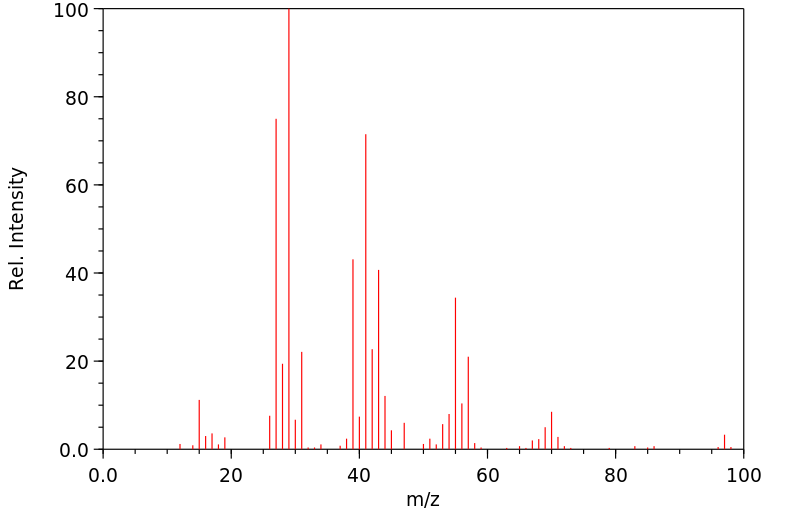庚基氢过氧化物 | 764-81-8
-
物化性质
-
计算性质
-
ADMET
-
安全信息
-
SDS
-
制备方法与用途
-
上下游信息
-
文献信息
-
表征谱图
-
同类化合物
-
相关功能分类
-
相关结构分类
物化性质
-
熔点:35.5°C
-
沸点:184.14°C (rough estimate)
-
密度:0.9202 (rough estimate)
计算性质
-
辛醇/水分配系数(LogP):2.5
-
重原子数:9
-
可旋转键数:6
-
环数:0.0
-
sp3杂化的碳原子比例:1.0
-
拓扑面积:29.5
-
氢给体数:1
-
氢受体数:2
SDS
上下游信息
反应信息
-
作为反应物:参考文献:名称:Intramolecular H-transfer reactions during the Decomposition of Alkylhydroperoxides in hydrocarbons as the solvents摘要:DOI:10.1002/prac.19943360109
-
作为产物:参考文献:名称:Peroxides. I. n-Alkyl Hydroperoxides摘要:DOI:10.1021/ja01640a036
文献信息
-
Oxidations by the reagent “O2–H2O2–vanadium derivative–pyrazine-2-carboxylic acid’. Part 12. Main features, kinetics and mechanism of alkane hydroperoxidation†作者:Georgiy B. Shul’pin、Yuriy N. Kozlov、Galina V. Nizova、Georg Süss-Fink、Sandrine Stanislas、Alex Kitaygorodskiy、Vera S. KulikovaDOI:10.1039/b101442k日期:——Various combinations of vanadium derivatives (n-Bu4NVO3 is the best catalyst) with pyrazine-2-carboxylic acid (PCA) catalyse the oxidation of saturated hydrocarbons, RH, with hydrogen peroxide and air in acetonitrile solution to produce, at temperatures <40 °C, alkyl hydroperoxides, ROOH, as the main primary products. These compounds are easily reduced with triphenylphosphine to the corresponding alcohols钒衍生物的各种组合(n -Bu 4 NVO 3是最好的催化剂),用吡嗪-2-羧酸(PCA)催化饱和烃RH的氧化,用过氧化氢和空气在乙腈溶液中的氧化,在<40°C的温度下生成烷基氢过氧化物ROOH作为主要催化剂农产品。这些化合物容易被三苯基膦还原成相应的醇,然后可以通过GLC定量测定。某些类似于PCA的氨基酸可以起到助催化剂的作用;但是,吡啶甲酸和咪唑-4,5-二羧酸的氧化速率和最终产物收率较低,而咪唑-4-羧酸和吡唑-3,5-二羧酸几乎没有活性。羟基自由基对烷烃RH的攻击引起氧化,从而产生烷基R 4。后者进一步与分子大气中的氧迅速反应。这样形成的过氧自由基ROO 3可以转化为氢过氧化物烷基。根据对环己烷氧化的动力学研究,我们得出结论,反应的限速步骤是含有一个配位PCA分子的复合物的单分子分解:VV(PCA)(H 2 O 2)→V IV(PCA)+HOO˙+ H +。在V IV由此物种发生反应形成进一步与第二H
-
Iron(II)-Catalyzed Site-Selective Functionalization of Unactivated C(sp<sup>3</sup> )−H Bonds Guided by Alkoxyl Radicals作者:Honghao Guan、Shutao Sun、Ying Mao、Lei Chen、Ran Lu、Jiancheng Huang、Lei LiuDOI:10.1002/anie.201806434日期:2018.8.27for site‐selective functionalization of unactivated methylene and methine C−H bonds enabled by an FeII‐catalyzed redox process is described. The mild, expeditious, and modular protocol allows efficient remote aliphatic fluorination, chlorination, amination, and alkynylation of structurally and electronically varied primary, secondary, and tertiary hydroperoxides with excellent functional‐group tolerance
-
Elongation Behavior of Calcaneofibular and Cervical Ligaments in a Closed Kinetic Chain: Pathomechanics of Lateral Hindfoot Instability作者:Lewis P. Martin、Jennifer S. Wayne、John R. Owen、Robert T. Smith、Sidney N. Martin、Robert S. AdelaarDOI:10.1177/107110070202300608日期:2002.6
Numerous reconstructive procedures are performed to correct both ankle and subtalar instability after trauma although the precise pathology which results in this chronic instability and pain is not yet known. This study examined the role of the calcaneofibular (CLFL) and cervical ligaments (CRVL) during physiologic loading and demonstrated the effect of CLFL deficiency on the CRVL. Talar and subtalar tilt as well as inversion range of motion before and after CLFL sectioning were studied. Eleven osteoligamentous fresh frozen cadaver legs were used in which each foot was taken through six positions: neutral, 35° plantarflexion, dorsiflexion, inversion, plantarflexion-inversion, and dorsiflexion-inversion. The CLFL and CRVL stretched the greatest in dorsiflexion-inversion. The most Interesting finding was that the CRVL was elongated relative to neutral in all other test positions of the foot. However, the CLFL was shortened relative to neutral in plantarflexion and plantarflexion-inversion. In the CLFL deficient state, CRVL ratios demonstrated significant increases in length of the CRVL. Talar tilt increased on average more than 9° with CLFL deficiency (p<0.008) while subtalar tilt did not change significantly. The maximum tibiocalcaneal angle, recorded for dorsiflexion-inversion, increased more than 5° after sectioning the CLFL (p<0.05).
大量的重建手术用于矫正创伤后踝关节和跟骨关节不稳定,尽管导致这种慢性不稳定和疼痛的确切病理机制尚不清楚。本研究探讨了生理负荷下跟腓韧带(CLFL)和颈韧带(CRVL)的作用,并展示了CLFL缺陷对CRVL的影响。研究了CLFL切除前后跖骨和跟骨的倾斜度以及内翻活动范围。使用了11条骨韧带新鲜冰冻尸体的腿,每只脚经历了六个位置:中立、35°背伸、屈伸、内翻、背伸内翻和屈伸内翻。CLFL和CRVL在背伸内翻时拉伸最大。最有趣的发现是,在其他所有测试脚位中,CRVL相对中立时延长。然而,在背伸和背伸内翻时,CLFL相对中立时缩短。在CLFL缺陷状态下,CRVL长度比例显示CRVL长度显著增加。CLFL缺陷时,跖骨倾斜平均增加超过9°(p<0.008),而跟骨倾斜没有显著变化。记录在背伸内翻时的最大胫跟角,在切除CLFL后增加了超过5°(p<0.05)。 -
Oxidation with the “O2−H2O2−VO3 −−pyrazine-2-carboxylic acid” reagent作者:M. C. Guerreiro、U. Schuchardt、G. B. Shul’pinDOI:10.1007/bf02495206日期:1997.4in acetonitrile under the action of H2O2 with a “vanadate anion-pyrazine-2-carboxylic acid” system as the catalyst in air to form isomeric heptyl hydroperoxides (detected by GLC) along with isomeric heptanols and heptanones. Heptyl hydroperoxides slowly decompose at low temperature yielding the corresponding alcohols and ketones (aldehyde). The values of the parameter of the relative normalized reactivity
-
Hydroperoxidation of methane and other alkanes with H2O2 catalyzed by a dinuclear iron complex and an amino acid作者:Galina V. Nizova、Bernt Krebs、Georg Süss-Fink、Siegfried Schindler、Lars Westerheide、Laura Gonzalez Cuervo、Georgiy B. Shul'pinDOI:10.1016/s0040-4020(02)01182-1日期:2002.11H2O (1) containing a dinuclear iron(III) complex in which HPTB=N,N,N′,N′-tetrakis(2-benzimidazolylmethyl)-2-hydroxo-1,3-diaminopropane catalyzes the oxidation of alkanes with hydrogen peroxide in acetonitrile solution at room temperature only if certain amino acids (pyrazine-2-carboxylic, pyrazine-2,3-dicarboxylic or picolinic acid) are added to the reaction mixture. Alkyl hydroperoxides are formed
表征谱图
-
氢谱1HNMR
-
质谱MS
-
碳谱13CNMR
-
红外IR
-
拉曼Raman
-
峰位数据
-
峰位匹配
-
表征信息







